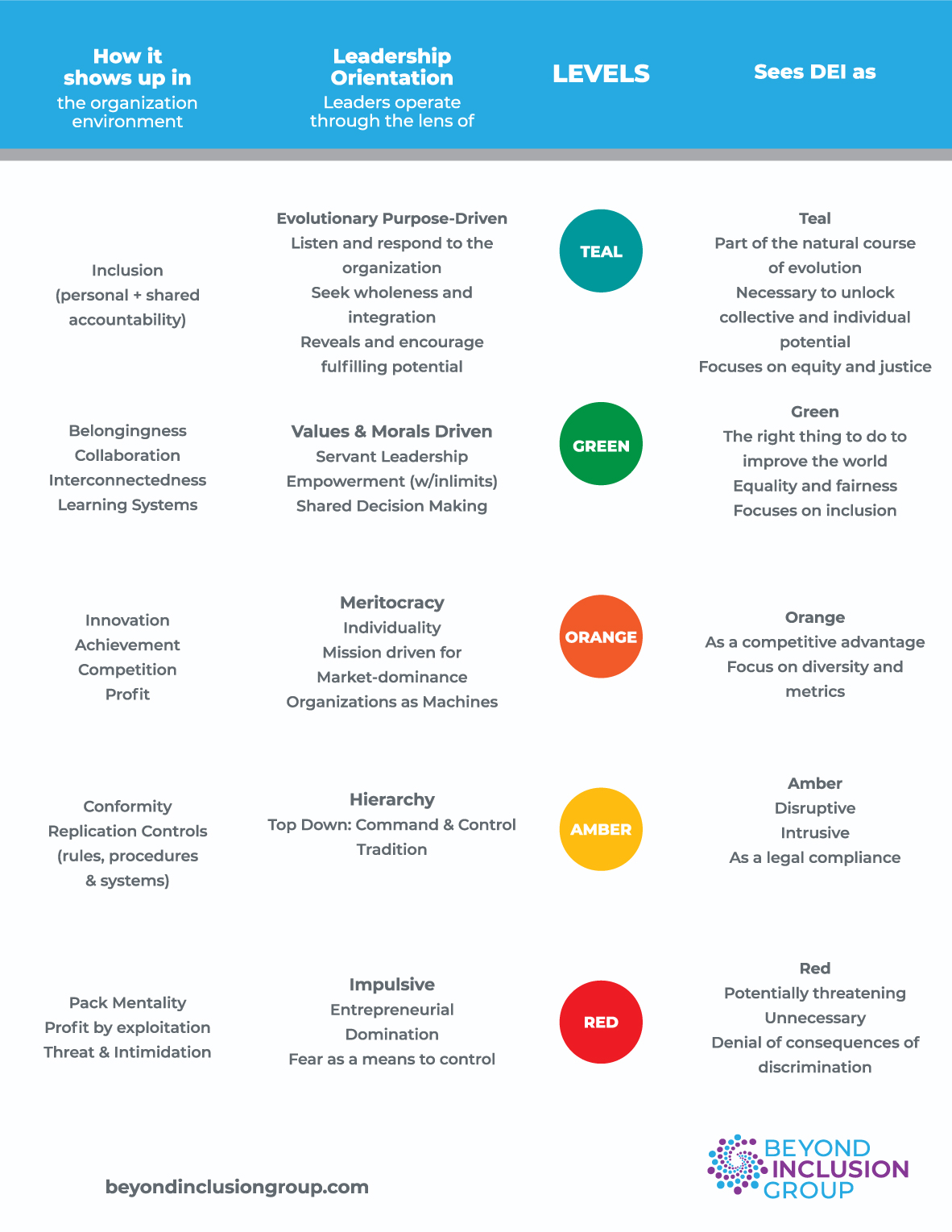
Embracing Discomfort To Fuel Inclusive Leadership
“Speaking up does not require having all the answers. It requires courage, clarity of values, and a willingness to learn out loud.”
"By embracing an evolutionary leadership framework, leaders can foster an environment where diversity is celebrated, creating stronger, more resilient teams. "
In the ever-changing landscape of the modern workplace, the concept of leadership has undergone significant transformations. Among these, the idea of evolutionary leadership has emerged as a holistic approach that integrates biological, psychological, and social dimensions to address the complexities of leading diverse teams. This concept is not only scientifically grounded but also offers a robust framework for understanding why certain leadership behaviors are effective across different cultures and contexts.
It’s clear that Diversity, Equity, and Inclusion (DEI) is pivotal in today’s globalized world. So what makes evolutionary leadership stand out from the dozens of well-known models and theories that have shaped our understanding of effective leadership?
Unlike other leadership theories that focus on the “what” and “how,” evolutionary leadership delves into the “why” of leadership behaviors, providing a deeper understanding of their origins and effectiveness. Yes, the other theories offer valuable insights, but evolutionary leadership stands out by providing a scientifically backed explanation for leadership behaviors. It roots its principles in our evolutionary past, offering a more fundamental and comprehensive understanding of leadership that other theories lack.
To be clear, inclusive leadership is not just a moral imperative; it also has tangible benefits for organizations. By embracing an evolutionary leadership framework, leaders can foster an environment where diversity is celebrated, creating stronger, more resilient teams.
The return on investment (or ROI) of inclusive leadership include:
Understanding the motivations, characteristics, and limitations of leadership approaches associated with the various stages of evolutionary leadership – Red (Impulsive), Amber (Hierarchy), Orange (Meritocracy), Green (Values Morals Driven), and Teal (Evolutionary Purpose-Driven) – can orient you, serving as a trustworthy guide on your inclusive leadership journey.

The Impulsive (Red) worldview originated 10,000 years ago as swelling group sizes necessitated new human survival strategies. This phase introduced well-known top-down power hierarchies and the concept of the division of labor, which were major innovations allowing groups to deal with unprecedented levels of social complexity. However, Red organizations are driven by a pack mentality where individuals are motivated by loyalty and fear inspired by the chief. Leaders operate with an “us versus them” mindset that sees differences as threats. Today, this mindset is primarily found in organized crime factions, street gangs, and small enterprises where founders do whatever it takes to succeed.
The Hierarchical (Amber) level began about 5,000 years ago with the rise of agriculture from the Fertile Crescent (Mesopotamia) outward, especially to the Eurasian continent. This stage marks humanity’s first multi-layered approach to organizing. Organizations rely on replicable processes and stable organizational charts, providing comfort through predictability and reliability. However, through the Amber lens, DEI initiatives are seen as disruptive because they call for exceptions to established rules, which are the backbone of Amber organizations. Questioning these rules is perceived as radical and destabilizing.
The Orange leadership orientation emerged during the Renaissance among scientists and artists and was broadly adopted about 300 years ago during the Industrial Age, leading to the Scientific Revolution. This stage has transformed humanity over the last two centuries, granting unparalleled levels of prosperity. The Orange mindset has contributed positively to social justice in the sense that it departed from the caste system and provided opportunities for some people to more freely choose occupations compatible with their needs, aspirations and aptitudes. Still, Orange leaders often fail to recognize that the playing field is not always leveled and some individuals have inherent advantages associated with social identities.
The Green leadership level began about 150 years ago, emphasizing holistic thinking, diversity, harmony, human development, and conservationism. This stage views the world as a shared habitat cared for by all, promoting peace, collaboration, and interpersonal connectivity. Despite its commendable values and intentions toward justice and tolerance for human differences, Green-level leaders often lack the mindset and skillset necessary to fully drive inclusion.Green leaders misguidedly believe that they are already inclusive, making it justifiable to overlook DEI initiatives because they seem superfluous, unnecessary, or something that the organization has already moved beyond.
The Teal approach to leadership began about 50 years ago, valuing authenticity, spontaneity, flexibility, and free-will choice. Teal leaders see the world as interconnected systems continuously evolving. They recognize being and becoming as more important than doing, embracing uncertainty, complexity, and shared accountability as part of collaborative momentum. While not as rigidly hierarchical, Teal organizations can struggle with decision-making speed and consistency due to their flexible, less structured approach.
Teal leaders are less focused on outcomes, granting them a nuanced perspective on data that means understanding people rather than just quantifying them. By contrast, leaders at the Orange Level often fail to question data that is incongruent with their own worldview. For example, an Orange leader will think of the number of minority individuals who are hired or fired merely as a function of competition and meritocracy. Teal leaders are more apt to consider how and why employee experiences manifest in recruitment and retention trends.
From a Teal perspective, leaders are better at leveraging emotional insights. While emotions are always present in the workplace, some leadership styles such as Orange tend to ignore them or see them only as distractions from efficiency and productivity. Green-style leaders, in another instance, may over-emphasize emotion such that staff are polarized as advocates for a mission and the risk for burnout is simultaneously higher yet constantly downplayed. Teal leaders, by contrast, tune into emotions to inform change and promote employee wellbeing.
Teal leaders are also able to tap freely into their intuition. The complex interplay of factors in the business world can’t always be captured in an analytical framework. Intuitive knowledge can support a more holistic understanding of the deep nature of today’s organizational problems. Leaders operating at the Teal level can make better decisions by accessing a higher spectrum of human experience combining logic, emotions, and intuition.
Paradoxes reveal incoherencies in logical systems and signal tensions in actions, behaviors, and systems within organizations. By embracing life paradoxes and moving beyond “either/or” thinking, Teal leaders can facilitate a deeper understanding of complex organizational challenges and find more opportunities to further organizational development and growth.
In Teal organizations, the emphasis on interconnectedness promotes collaboration, wholeness, and community that feeds the potential for innovation while breaking down the damaging silo approach characteristic of other levels of development.
Evolutionary leadership provides a powerful framework for addressing the challenges of leading diverse teams in today’s complex world. By understanding the stages of leadership evolution and the importance of DEI, leaders can create more inclusive, productive, and resilient organizations.
Research shows that in Teal organizations:
There are two ways you can take the first steps towards pursuing evolutionary leadership in your organization:
 Download the Evolutionary Guide to Diversity, Equity and Inclusion – Expanding your organization while fulfilling your purpose and creating new growth is a noble cause. By downloading the Evolutionary Guide to Diversity, Equity and Inclusion, you’ll uncover:
Download the Evolutionary Guide to Diversity, Equity and Inclusion – Expanding your organization while fulfilling your purpose and creating new growth is a noble cause. By downloading the Evolutionary Guide to Diversity, Equity and Inclusion, you’ll uncover:

Participate in the Evolutionary Leadership Program (Coming Soon) – The rapid pace of change in today’s business world demands leaders who can navigate uncertainty with confidence and clarity. Are you able to meet that demand?
The Evolutionary Leadership Program will enable you to stay ahead of the curve, so you can lead with confidence and purpose in dynamic environments. By embracing uncertainty and nurturing distributed authentic leadership, we enable leaders like you to transcend existing paradigms about themselves and their organizations.
This program is your pathway to becoming a leader who not only navigates change but drives it with purpose and systemic insight. Allow us to transform your leadership journey to create meaningful impact in your career and your organization.
Embrace the journey of evolutionary leadership to unlock the full potential of your team and foster a workplace where everyone thrives.

“Speaking up does not require having all the answers. It requires courage, clarity of values, and a willingness to learn out loud.”

“Studies reveal that more than 40% of our behaviors are driven by fixed beliefs, habits, biases, and blind spots.”
Stay up to date on news, events, webinars and more from Beyond Inclusion Group.